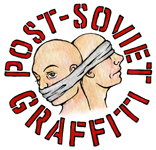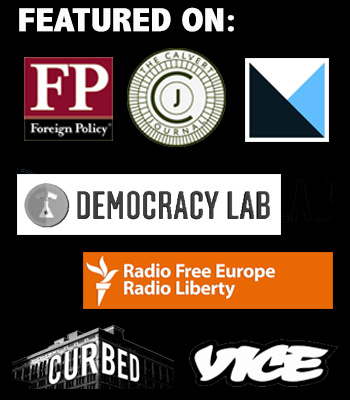The Graffiti-Producing Counter-Cultures of the Soviet Era
According to the social history presented by John Bushnell in his 1990 book Moscow Graffiti: Language and Subculture, the unadorned graffiti of hippies, punks, soccer hooligans, and pacifists dominated Russia’s public sphere in the late Soviet period. The subculture youth of the late Soviet period used graffiti as a rebellious medium to express their non-conformist ideologies. In chalk, in oil paint and brush, or—before the early 1980s—less commonly in spray paint, Soviet graffiti artists attempted to infiltrate the government-controlled public sphere with peace sign symbols, popular rock references, and Nazi swastikas. While records of explicitly dissident graffiti exist these instances were uncommon. Bushnell states that dissident graffiti were: “so unusual that they set off KGB investigations, and sometimes political trials (Bushnell, P113).” Overall Soviet graffiti writers avoided direct political aggressions, instead concerning themselves with the soft politics of Afghanistan war protest, dissent toward American imperialism, anti-nuclear armament sentiment, and the freedom to musical and artistic expression.
While the history of Russian graffiti likely dates prior to the formation of the ninth century Rurik Dynasty (when graffiti largely served a labelling or basic advertising function), graffiti by its modern definition—writing on public walls to convey a message, however vulgar or seemingly meaningless—was first recorded in the early 1970s and credited to Soviet football fanatics. Football fans (fanaty in Russian) broadcast their allegiance to FC Spartak Moscow, FC Dinamo Moscow, or TsSKA by etching the team’s name or the team captain’s name on the walls of Moscow’s residential outskirts. Often lacking forethought, fan graffiti quickly devolved to reflect the belligerence of their artists’ raucous, boyish, and instigative behavior, such as the stencil that suggests fans “Fight for Zenith” [Figure 6]. Over time the fanaty and their graffiti developed an association with more extreme gang lifestyles, excessively vulgar speech, and violent hooliganism.
Though suspicious of the genre’s subversive messages and popular influence, party leadership softened toward Soviet-born rock groups the late 1970s. By means of concert tours and relatable lyrics, domestic musicians began to develop fan bases. State support for foreign artists soon followed; on May 20th 1979 authorities invited British crooner Elton John to Soviet soil for a concert and later that year, per Soviet request, American blues guitarist B. B. King added a Moscow stop to his world tour. By the early 1980s, the youth influenced by rock-and-roll began to dedicate their graffiti to foreign rock groups like AC/DC, the Sex Pistols, and Led Zeppelin. By 1983-1984, their music-themed writing accounted for 20-25 percent of total graffiti in Russia (Bushnell, P68).

“Good Night White Pride,” “White Patriot,” “Punk’s Not Dead.” August 2011. Saint Petersburg, Russia. (Photo: Alexis Zimberg).
In June 1983 Konstantin Chernenko, then Minister of Ideology, announced to the Communist Party Central Committee that the rockers were causing ideological and aesthetic harm to the Soviet ideology (Bushnell, P76). Swiftly the Soviet leadership repressed the rock community by denying performances, censoring lyrics, and requiring the dissolution of many non-conformist groups. Genre participants reacted in a wave of creative, cosmetic changes; musicians reworked band names to sever their future projects from their former identities (now deemed un-Soviet by the authorities), the black market capitalized on selling outlawed tapes, and thousands of artists simply declined to register themselves with state officials, further enhancing their rocker authenticity (Bushnell, P77). One year later in 1984, Mikhail Gorbachev took office and introduced the Soviet policies of perestroika and glasnost’. Perestroika, loosely translated into English as restructuring, introduced pseudo-market economic reforms to the Communist model. Gorbachev’s glasnost’, defined in English as openness, established a more transparent government and encouraged free debate. The latter policy resulted in a significant loosening of media censorship and increased individual speech freedoms. In correspondence with the opening created by these top-down reforms, the rock scene made a state-supported comeback.

“Fight for Zenith (a Saint Petersburg-based Football Team).” August 2011. Saint Petersburg, Russia. (Photo: Alexis Zimberg).
In the mid-to-late 1980s rock music returned to once again rest at the center of the Soviet subculture for everyone from the heavy metal Iron Maiden idolizers to the peace-loving Beatles fans. By 1988, half of Moscow’s graffiti was about rock-and-roll and increasingly centralized on permitted graffiti spaces known as fan walls. When Viktor Tsoi, the lead singer of popular rock band Kino, died tragically in 1990, his loyal listeners expressed their remorse on a still-existing fan wall near the far end of the Staryi Arbat. Today fans continue to memorialize the fallen Tsoi as a symbol of peace and a figure of youthful independence by contributing to the fan wall. Punk lovers, ideologically opposed to figures of authority, also began to systematically tattoo the Soviet streets with their chosen badge, the anarchist symbol. Though fanaty and rockers largely dominated the late Soviet graffiti scene, other subcultural youth movements—hippies, pacifists, and fascists—also edged their way into the public square.
The Soviet Union’s most explicitly political graffiti messages appeared in the early 1980s. During this time, hippie youth used the walls to share the international peace sign symbol, calls for universal free love, and poetic slogans about brotherly kindness (“Make Hair Everywhere,” “Long Live Butterflies,” among these) (Bushnell, P116)). Pacifist groups such as the Free Initiative meanwhile focused their political advocacy efforts on the moral wrongs of war and violence. While state threats of detention and arrest frequently derailed their demonstrative efforts, pacifists remained undeterred to speak out against the wars that they opposed. Alienated from the censored Soviet press and public sphere, Soviet anti-war demonstrators used graffiti to publicize their opposition to the Soviet Union’s 1979 invasion of Afghanistan, the United States’ imperial expansion, and the heightened threat posed by Cold War nuclear power, using slogans such as: “End the Shameful War in Afghanistan,” “Out of Afghanistan,” “Gorbachev—Murderer of Afghan Children,” and “Russian Children’s Skin is Just as Sensitive to Napalm as Afghan Skin (Bushnell, Pp 120-121).” Today, hippies and pacifists continue to draw peace signs and paint against nuclear armament, writing statements such as “Atoms Cannot Be Peaceful” and painting murals of the negative impact of nuclear energy on the environment.

A couple enjoys a romantic moment at the Bay of Finland. Below: “Heil Hitler.” August 2011. Saint Petersburg, Russia. (Photo: Alexis Zimberg).
The fascist revival of the early-1970s and its impact on the Soviet street narrative cannot be ignored. Graffitied slogans of “Russia for Russians,” “Heil Hitler,” and “14/88” began to frequent urban centers by the early 1980s. On 20 April 1982—Hitler’s birthday—Moscow’s neo-fascist counter-culture made its public debut at an unsanctioned Pushkinskaia Square demonstration. With the understanding that their ideology is more about Russian nationalism than Nazism, the neo-fascist reverence for Hitler in a country so negatively affected by World War Two is overtly instigative. Bushnell explains that the neo-fascists “esteem Hitler not so much for his specific beliefs—certainly not for his ideas about Slavs—but for his concept of racial purity and his example of dynamic, authoritarian rule… The fascists have chosen deliberatively to offend: their purpose is as much rebellion against political verities as it is promotion of a set of political views. They resemble in that way the counterculture they claim to despise (Bushnell, P153).” Seeking maximum exposure in the public consciousness, the leather-jacketed youth became active graffiti writers, especially outside of Moscow’s urban center (Bushnell, Pp153-160). Fascist graffiti—swastikas, the lightning-bolted SS insignia, and anti-Semitic slurs—long outlasted the Soviet Union and slogans such as “Love Your Own Race” continue to permeate the public spaces across the contemporary post-Soviet sphere.
These graffitied ethnic confrontations by skinhead youth writers do not exist in a vacuum. Documented as early as 1983 in Russia, an anti-fascist revivalist counterculture took to the streets with responsive demands for a Russian reality void of fascism and fascists. Anti-fascist writers engaged their counterparts in discourse by crossing out fascist symbols or dwarfing them with peace signs. Today, Russian anti-fascist activists, commonly referred to as members of the European Antifa movement, paint graffiti about life sans extreme nationalism, writing slogans such as: “Russia without Fascism,” “Art Without Fascism,” “Yellow, Red, White, Black, We Are All the Same,” and “Good Night White Pride.”

A Soviet Mural Welcomes Visitors to Transcarpathia, Ukraine. July 2011. Chop, Ukraine. (Photo: Alexis Zimberg).
This post is the first installment of a six-part series on the history of graffiti and street art in Russia. Coming next is part two: ‘Breaking’ Into Contemporary Graffiti.








![[VICE] The Silent Protest of Post-Soviet Graffiti](http://postsovietgraffiti.com/wp-content/uploads/2016/01/vice-1-140x90.jpg)





Fantastic goods from you, man. I’ve understand your stuff prieovus to and you’re just too wonderful. I really like what you’ve acquired here, certainly like what you’re stating and the way in which you say it. You make it entertaining and you still take care of to keep it sensible. I can’t wait to read much more from you. This is actually a great web site.
It’s a shame you don’t have a donate button! I’d certainly donate to this fantastic blog!
I guess for now i’ll settle for bookmarking and adding your RSS feed to my Google account.
I look forward to fresh updates and will talk about this
site with my Facebook group. Talk soon!